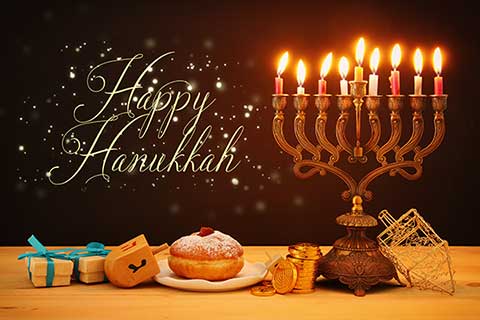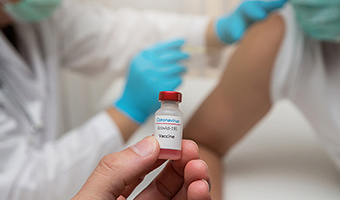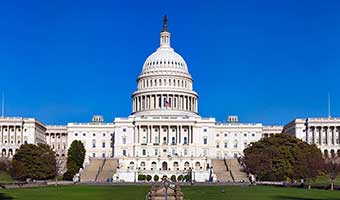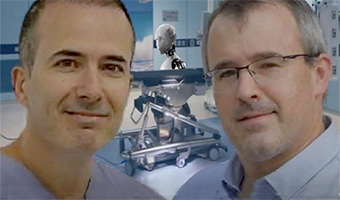
Eighth Hanukkah Candle's Miracle: From Darkness to Light
The last day of Hanukkah has a special name in Hebrew: Zot Hanukkah. It's as if you are pointing with your finger and saying, "That is Hanukkah," reminding us that the great light of hope can illuminate the darkness.
That is a theme of the Hadassah Medical Organization, beginning with medical care for children walking around with flies in their eyes and mothers who had only a 50 percent chance of surviving childbirth.
Hadassah is a movement that saves the Jewish children of the world when they have no place to go. It is a mission that heals children from countries like Syria, where there is no help for those with complicated heart defects, and children from Ethiopia with twisted spines.
On an ongoing basis, Hadassah physicians share their medical expertise with colleagues from around the world. Each day, 70 physicians come to learn at Hadassah from the Palestinian Authority. Hundreds of others are getting their training from Hadassah staff, too.
Take, for example, ophthalmologist Eleanor Nche. She comes from Cameroon in Central Africa, a country of 23 million people with a life expectancy of 56. Over one percent of the population is blind. In 2012, four of Hadassah's eye doctors went there and operated to restore eyesight. Dr. Eleanor, as she is fondly called at Hadassah, was so inspired by this outreach that she came to Hadassah to study.
Dr. Eleanor is also a single mom. Her father took care of her little girl while she trained at Hadassah. When he passed away suddenly, Hadassah helped get permission for the girl to come to Israel. Because Israel's school day ends at 1:00 pm, the doctors in the ophthalmology department all contributed from their own pockets to pay for the afterschool program. That's the Hadassah spirit, from the days of its founder Henrietta Szold until today.
Zot Hanukkah.
Sixth and Seventh Candles' Hanukkah Miracle: Hadassah Nurse Extraordinaire
- At 100 years old, Judith still volunteers at the Hadassah-Hebrew University Henrietta Szold School of Nursing.
- Judith came to Jerusalem from Czechoslovakia on a rare student visa, granted by the British authorities.
- A star nursing graduate, Judith was immediately promoted to teacher.
- During the attack on the Hadassah convoy on April 13, 1948, Judith continued teaching because she knew war was coming, and Israel would need nurses.
- Judith traveled to Malawi to train nurses.
- Judith knew Henrietta Szold.
- After becoming the director of the Henrietta Szold School of Nursing, Judith succeeded in making nursing an academic profession in Israel.
- Judith always has coffee and cake, European style, at four o'clock in the afternoon.
- It is true that her late husband was a cousin of Sigmund Freud, the psychoanalyst, but Judith waves away disappointments by saying, "it's not the end of the world."
- Judith blesses all of us to reach age 100 with "a good mind and good legs."
Happily, the number of transplants at the Hadassah Medical Organization is growing all the time, thanks to altruistic donors like Esti.
Fifth Candle's Hanukkah Miracle: New Sphere of Joy for Kidney Donor
"I'm so happy it feels like my wedding day," Esti Lerer, the petite, hazel-eyed Hassidic youth worker and mother of three said last year when she donated one of her kidneys to Tomer Tarfa Darja, age 23.
Since then, Tomer has become part of Esti's large extended family. He spends Sabbaths with them, and the Lerers include him on family trips. Tomer and Esti are both feeling fine. He's back to his studies and she's busy with work and her children.
"Tomer always wants to thank me, but I need to thank him," Esti says. "All I gave him was a seven-ounce kidney, and he gave me a whole new sphere of joy and meaning. It's hard to express the elation and ebullience of knowing that I am so fortunate to be able to save a life."
At 28, Lerer was among Israel's youngest altruistic kidney donors. "Along the way, I was repeatedly told I was nuts, that I should come back at age 40," she recalled. "The worst was when a nephrologist in Tel Aviv tore up my file. But at Hadassah Hospital, I was treated with professionalism and understanding."
When Esti was a teen, her best friend's father died of kidney disease. Esti had made up her mind then to donate her kidney when she grew up. It was among the important facts about herself that she shared with her husband-to-be on their first date.
Tomer is the youngest of seven children. He immigrated to Israel from Ethiopia with his widowed mother when he was a toddler. Hoping to serve in an elite unit of the Israel Defense Forces, he was taking a year in a pre-army yeshiva for extra training when he fell sick. What was first misdiagnosed as gastroenteritis turned out to be kidney disease.
The surgeon for both Esti and Tomer was Dr. Abed Khalailah. "It was a perfect match," says Dr. Khailailah. Esti agrees. "A match made in heaven."
Happily, the number of transplants at the Hadassah Medical Organization is growing all the time, thanks to altruistic donors like Esti.
Fourth Candle's Hanukkah Miracle: A Journey from Paralysis to Recovery
After his training for a combat unit in the Israel Defense Forces, the handsome, muscular soldier was the most fit he'd ever been. With ease, he ran up hills, carried heavy equipment, and aced weapons training. And then, suddenly, he had trouble walking. Paralysis spread throughout his body. Dvir Teitelbaum, age 21, was struck by Guillain-Barré syndrome, a neurological disorder in which the immune system attacks the nervous system.
An awful moment for Dvir was watching a mosquito feast on his arm and being unable to swat it away. At Hadassah Hospital Ein Kerem, his illness was treated, and then he began arduous rehabilitation at Hadassah Hospital Mount Scopus, where he received physical, occupational, neurological, and psychological therapy to regain his strength and spirit.
"I got my life back at Hadassah's hospitals," says Dvir. "I never realized how important the work of Hadassah's supporters is until I needed it. How wonderful it is that Hadassah is going to expand the rehabilitation center so more soldiers like me and civilians can be helped."
The name Dvir means the innermost sanctum, the holy of holies, of the ancient Temple. Hanukkah marks the miracle of the Temple rededication.
"Last year, Dvir couldn't even light a candle," relates his mom Rachel Teitelbaum. "This week, we're lighting our Hanukkah candles as a thanksgiving celebration of Dvir's s recovery."
Third Candle's Hanukkah Miracle: From Child of Ukraine to Israeli Rocket Engineer
When Inna Stepanova Zamir was 14, she didn't know anything about being Jewish. "My maternal grandparents had suffered so much from antisemitism that they didn't want my mother to discuss our Jewishness," she explains.
But then Zamir and her sister, Anya, attended some Jewish Agency programs in their hometown of Kharkov, a major city in the Ukraine. A Zionist flame was ignited for the sisters. They applied to take part in the Naaleh program, where teens go by themselves to Israel to study.
As excellent students, they were both accepted. By the time Inna was 15, they were living and studying at Hadassah's Meir Shfeya Youth Aliyah village. "There was a lot to adjust to—new language, new food, and kids who tell you everything that is on their mind," she says. "We were pampered city kids, and suddenly I was collecting eggs and working in the dining hall."
Adjust she did, however. “When I went into the Israel Defense Forces, I was better prepared than most for communal living,” she recalls. Zamir was featured in the news apprehending a terrorist trying to cross into Israel. "He looked shifty," she relates, "and I had experience at reading body language."
Zamir always had an inclination toward physics and math and was well prepared by Meir Shfeya's prize-winning school for studies in the Aeronautic Engineering faculty of the Technion. She married one of her engineering classmates whom she knew from the army. In the meantime, her parents, inspired by their Zionist daughters, moved to Israel.
Zamir was in the news again recently when she won the 2019 Gemunder Prize, which will fund her future studies and research. Her doctorate is on timing of rocket propulsion.
"I want to thank the women of Hadassah for their longtime support of Meir Shfeya, which has made it the embracing, high-level educational institution it is and for caring about students like me," relates Zamir. "You provided the bridge between my childhood in the Ukraine and my life in Israel. You made me part of the Hadassah family, not only when I was a student but forever. You gave me my future."
Now Zamir is helping to secure the safety of Israel’s future.
Hadassah, the Women’s Zionist Organization of America, has been supporting Youth Aliyah since the first European teens were rescued from Hitler in 1933. Since then, Hadassah has helped thousands of Youth Aliyah children achieve their dreams.
Second Candle's Hanukkah Miracle: From Rocky Start to Service in IDF
Bussi, Kachanga, Zinga. What do these obscure islands on Lake Victoria in Uganda have to do with Hadassah and Hanukkah? Hadassah Medical Organization's AIDS specialist Prof. Dan Engelhard was recently alerted by a student to the fact that the children in an orphanage there were dying of AIDS.
Had this call come 15 years earlier, Prof. Engelhard wouldn't have been surprised. That's when he first visited Addis Ababa, Ethiopia, where nuns were ministering to 400 children dying of AIDS at the Mother Theresa orphanage. Back then, Prof. Engelhard enlisted Hadassah volunteers to help, supplied anti-retroviral treatment through the then new United States Emergency Plan, and taught the local staff what to do.
Still, Prof. Engelhard knew that it wouldn't be enough. The successful Hadassah approach to combatting AIDS was multidisciplinary. In Israel, psychologists, social workers, and community guides dealt with social stigmas, school problems, and compliance issues. At Pill School, children learned to swallow their medications. For five years, a Train the Trainers program for African doctors and nurses was offered at Hadassah, so they could learn the Hadassah method. The mortality rate in orphanages dropped to one percent. The good news spread.
Still, in 2019, the HIV/AIDS treatment revolution had not reached the remote Lake Victoria islands, where prevalence of HIV/AIDS was still as high as 40 percent. Traveling fishermen were reportedly spreading the disease. Prof. Engelhard used his contacts to get these overlooked children into a regimen of lifesaving care.
In this season of commemorating miracles, Prof. Engelhard shared a story with Barbara Sofer, public relations director of the Hadassah Office in Israel. It is about one HIV positive child who was given a chance to have a quality life by an Israeli woman. As a baby, she had been adopted from Europe, but when her adoptive parents learned that the agency had not disclosed that she was HIV positive, they abandoned her. It was then that an Israeli single mom adopted her and enrolled her in Hadassah Hospital's multidisciplinary treatment program.
Today that little girl, who was born with a deadly disease and abandoned twice, is a healthy young woman in a fighting unit of the Israel Defense Forces. And this Hanukkah, for the first time, the boys and girls of Bussi, Kachanga, and Zinga have hope because of a Hadassah doctor.
Doing his job wasn't enough for Prof. Engelhard. Like many of Hadassah's staff, he carries forward the Hadassah volunteer spirit and brings light to the neediest in Israel and to the darkest parts of the world.
Prof. Engelhard and his team have brought light and life to thousands of children in Israel and tens of thousands—maybe hundreds of thousands—in Africa.
First Candle's Hanukkah Miracle: Terror Victim Becomes Mom
How could one begin talking about Hanukkah miracles without mentioning baby Eitan Iri Guertzenstein?
True, he's one of the more than 14,000 babies born at Hadassah's two hospitals this year, and each is a miracle. Still, Eitan Iri, son of Aluma Mekaitan and Mikael Guertzenstein, was the featured miracle story of Israel's popular daily newspaper Yediot Ahronot on Sunday, right before the lighting of the first Hanukkah candle.
Aluma was a 17- year-old high school student on her way to a math test in a prestigious Jerusalem high school when a terrorist blew up her bus. She was left among the dead at first, but a medic saw her move an eyebrow. A young neurosurgeon from Argentina was visiting hometown colleagues at Hadassah Hospital Ein Kerem when Aluma was brought in. He was an expert in repairing catastrophic brain injuries using a then new method of inserting thin metal coils into the damaged blood vessels. He joined the Hadassah team operating on Aluma and was so moved by the need to save terror victims like Aluma that he decided to stay in Israel. Today he is Prof. Jose Cohen and he has saved thousands of lives.
When Aluma woke up, she needed to learn to walk and talk again at Hadassah's Mount Scopus Rehabilitation Center. Her right arm remained paralyzed, but she managed to complete three university degrees. Almost ready to give up on completing another life goal of getting married and having a child, she nearly hung up the phone when Mikael Guertzenstein, a new immigrant from Lausanne, Switzerland asked her out. She had a cold. He, a chef, made her soup. The rest is history. Almost to the day, 17 years after the 17-year-old was saved at Hadassah Hospital, her beautiful and healthy baby came into the world with the help of Hadassah's experienced obstetrics staff. In the Yediot news story, Aluma also thanked the members of Hadassah, the Women's Zionist Organization of America (HWZOA), who have remained by her side.
And the brit (circumcision ceremony)? It was held in the Abbell Synagogue under the Chagall Windows. Representatives of HWZOA were there, and so was an emotional Prof. Cohen, who held the baby before letting another surgeon—the mohel—bring Eitan Iri into the covenant of Abraham and Sarah, and also into the Hadassah family.









